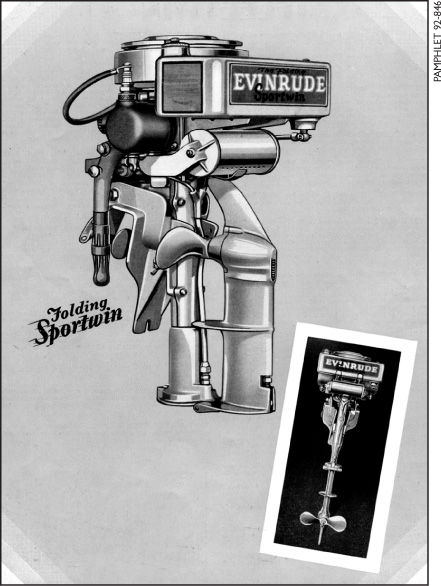
5
A Captain of Industry

Ole Evinrude came from a generation of immigrants who made their own way in the world without much education. Ole’s formal education had ended in third grade. Even so, over the years, he managed to educate himself in all of the subjects he needed to be successful in engineering and in business. But immigrants who did well in the United States expected something better for their children. Unlike Ole himself, Ole’s son, Ralph, didn’t have to worry about earning a living as a young man. His father was happy to support him while he finished college. That’s exactly what Ole expected to happen. But sometimes things don’t work out as expected.
Ralph Evinrude enrolled at the University of Wisconsin in 1926. During the summer, Ralph worked at the Elto plant and helped with the development of the soon-to-be-released Quad motor. At the end of his sophomore year of college, Ralph asked his parents if he could leave school “for just a semester” in order to see the Quad project through to completion. It turned out that Ralph, like his father, was more comfortable in business than in school. He never went back to the university.
While Ole’s Elto business was zooming along, the old Evinrude company was lagging far behind. The company was sold again in 1925. It was sold yet again in 1928 to Milwaukee manufacturing giant Briggs & Stratton. This company made portable gasoline engines and parts for automobiles. Briggs & Stratton invested hundreds of thousands of dollars in the Evinrude plant but still couldn’t make the company profitable. Stephen Briggs, president of Briggs & Stratton, got the idea to form a new group of investors to buy Evinrude from his company. The first person he approached was Ole Evinrude. Ole didn’t have much to gain from buying into the Evinrude company. After all, Elto was doing very well and Evinrude was not. But he couldn’t resist the chance to get back the company that bore his own name, not to mention Evinrude’s fancy new factory. So Ole agreed, and in 1929, a new corporation was formed through the merger of 3 companies: Evinrude Motors, Elto Outboard Motor Company, and the smaller Lockwood Motor Company of Jackson, Michigan. The new company they created was called Outboard Motors Corporation (OMC). Ole was named company president. Stephen Briggs was named chairman of the board of directors. Ralph Evinrude took on the position of export manager for the newly created corporation. The 3 companies would still be run as separate businesses, but all were really parts of OMC.

This man and woman caught lots of fish in their boat powered by an Evinrude motor.
The Evinrude Motor Company plant in Milwaukee, 1929.
The formation of OMC set the stage for a head-to-head battle with Johnson for control of the outboard motor business. But their timing could not have been worse. The year 1929 marked the beginning of the Great Depression. Many people had borrowed money from the bank to buy cars, homes, and other goods in the 1920s. But banks lent too much money. Prices fell. Banks failed. Factories closed, so many workers lost their jobs. Many people could barely afford to buy food and clothing. They stopped buying some things altogether, like outboard motors.

Ole and Stephen Briggs in 1929, the year they formed OMC.
The company, already in debt from the merger, began to lose money quickly. With falling sales, Lockwood, the smallest of the 3 units that made up OMC, was closed down in 1930. In 1931 OMC managed to sell only a little more than 10,000 of its motors. Wages for the company’s factory workers went down by about two-thirds. Factory hours were down to just 18 hours a week. Ole decided to give up his $25,000 salary in order to help the company stay in business.

During the Great Depression, Evinrude tried making new products, including camping stoves and motorized bikes.

The cover of a 1929 pamphlet that called Evinrude racing motors the “World’s Most Victorious Motors.”
In spite of these problems, Ole and his team continued to come up with new ideas. They knew the Great Depression would eventually end. They wanted to have the best motors ready for when that happened. In 1930, OMC brought out a new line of motors called the Fold-Lite. The Fold-Lite was the world’s lightest twin-cylinder motor, weighing only 29 pounds. But more important, the motor could be folded up to the size of a suitcase. You could throw it into the trunk of your car or take it along on a train for an out-of-town vacation. OMC sold only 10,291 motors in 1931, but Johnson’s sales were falling even faster. For the first time, OMC became the biggest producer of outboard motors in the world. OMC kept the lead for decades.

Another 1929 model was the Folding Sportwin.
In 1933, Bess’s health, which had been weak for her entire adult life, began to fail again. This time, she was not able to bounce back. Bess died on May 13, 1933. Ole was devastated by his wife’s death. His friends said he spent the next year drifting around in a lonely daze. He never recovered from the loss of the woman who had been his partner in business and in life. Ole died on July 12, 1934, at the age of 57. In less than a year and a half, the world lost the husband-wife team that first told the public, “Don’t row!”